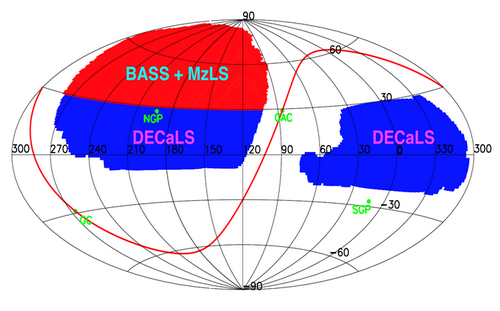After the first data release (DR1) was released in January of 2017, the Beijing-Arizona Sky Survey (BASS, http://batc.bao.ac.cn/BASS) has obtained new observed data and updated the data reduction pipelines. With the efforts of the BASS team, the second data release (DR2) is now publicly available to the world. It is the first time to include the z-band observations taken by a US team. As an open survey, the BASS has no proprietary. The BASS data is open for astronomers all over the world.
BASS is a collaborative program between NAOC and University of Arizona (UA). The PIs are Prof. Xu Zhou and Hu Zou from NAOC and Prof. Xiaohui Fan from UA. The BASS project plans to use the 2.3m Bok telescope to cover an area of 5500 square degrees in the north Galactic plane with g and r bands in three to four years. BASS, together with DECaLS and MzLS (two surveys leaded by US) will provide photometric catalogs for spectroscopic target selections of the upcoming Dark Energy Spectroscopic Instrument (DESI). The MzLS cover the same area as the BASS, providing the z-band images.
After three-year observations (2015-2017), the BASS completed about 72% of the observation. The total allocated nights are over 250. Another 100 nights are needed to finished all the observations and meanwhile the depths meet the requirements (g=24 and r=23.4 mag). The MzLS use the 4m Mayall telescope from US NOAO. It completed about 76% of the footprint in 2016 and 2017. The survey will complete the rest observations in February of 2018, and the desired depth is 23 mag.
BASS published the early data and DR1 in December 2015 and January 2017, respectively. In June 2017, the BASS data were merged into the DESI imaging products, which is prepared for the future DESI survey. Compared with DR1 that only includes the observations as June 2016, DR2 contains the BASS data as of July 2017 and the MzLS z-band data for the first time. New data reduction pipelines are adopted in DR2. For the astrometry, the Gaia catalogs are used as the reference catalog. The astrometric accuracy can reach to 0.03 arcsec, which is much better than the SDSS/2MASS as the reference. In addition to using the Pan-STARRS catalogs to make flux calibration, an internal calibration is performed. It improves the accuracy of the photometric calibration. For the photometry, a new developed photometric software is adopted. It turns out that the photometric accuracy is much better than the SDSS and the depths meet the requirements.
The DR2 products includes sing-epoch images and catalogs, stacked images and co-added catalogs, and sky viewer. Related data and information can be refereed to the data release webpage (http://batc.bao.ac.cn/BASS/doku.php?id=datarelease). The data services are supported by Chinese Astronomical Data Center and Ali Cloud. There are 0.35 billion stars and galaxies in the co-added catalogs. It has been the largest catalog published in China so far. In future, the BASS team will continue to upgrade the software and complete all the observations and produce higher-quality data products. Based on the data, the studies of the Milk Way and galaxies will be performed.

Footprints of BASS, MzLS and DECaLS Surveys.

Observational progresses of BASS and MzLS. The area is scanned three times for each filter.

Address: 20A Datun Road, Chaoyang District, Beijing, China code: 100012
Tel: 010-64888708 E-mail: naoc@nao.cas.cn

